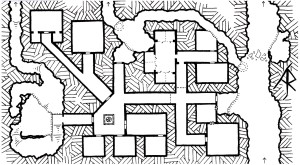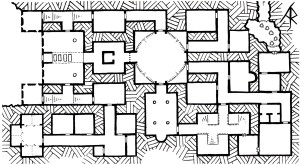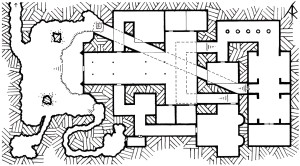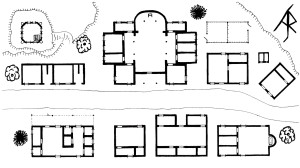
Mogget, a Free-magic Elemental
Free-magic Elemental
Elemental, CN, 40’ Flying, 8 / 12 / 16 HD, AC 2 / 0 / -2, 1d8 / 2d6 / 3d8 + 1d6 to Magic Users, F8 / F12 / F16, Mo 10, xp 2560 / 3600 / 5100
A Free-magic Elemental is an agent of pure chaos and possess a mind of burning raw magic. They don’t care about concepts like good or evil; they delight mainly in the havoc caused by possessing a magic item and using its powers in interesting ways and the frustration instilled in magic-users when their magic goes haywire.
They hunger for magic items to feed upon and may ally with a mortal for a time if it’s promised a choice magic item in payment, though it may decide, when the job is done, that it was not enough (or that his other magic items look tasty too).
They hate sentient magic items and those who ally with them. Oddly enough, the reason for its enmity is that the elemental sees the wielder as a slave-master of its kind, though it sees the sentient item as a rival to be consumed, rather than released.
Free-magic elementals are capable of speech and they know Common, Auran, Ignan, and the Chaotic alignment language.
Elemental Resistances:
An Elemental is immune to Sleep effects, paralyzation, and critical hits (if your game uses them).
A Free-magic Elemental appears as a very bright, energetic fire or smoke with a thin, spindly, vaguely humanoid form. Its color is usually white, electric blue, or neon green. It is 1’ tall and 3” in diameter per HD it has.
Magic-bane:
Free-magic’s chaotic nature causes feedback when a magic-using character is struck. They take an extra 1d6 damage as a result. Generally, only those who use arcane magic are affected; divine magic-users like clerics and druids are not affected.
Free-magic Aura:
A Free-magic Elemental has a 40’ aura surrounding it that causes all magic to go awry. Whenever any spell is cast within this aura, the spellcaster must make a Save vs Spells or roll a d% as if a Rod of Wonder had been used to determine the spell’s effect. Those who Save against this effect are still subject to this effect on future spells.
The aura can be dispelled with a successful Dispel Magic, but the Free-magic Elemental can reassert this aura as a free-action on its next turn.
In general, this aura affects both arcane and divine spells, spells cast from scrolls, wands, and rods (though the Save is that of the item’s wielder), but not the personal or inherent effects of permanent magic items. For example, a Dancing Sword‘s dancing ability or a Rod’s transformation abilities would still function normally.
Possess Magic Item:
A Free-magic Elemental can enter any magic item (like an enchanted ring, suit of armor, a wand, or a sword, but not single-use items like scrolls or potions) and may animate it in a limited fashion if it has moving parts, depending on its form. A possessed item cannot move any unmoving parts, so a cloak could billow or crawl, a suit of armor could walk, or a sword swing if held by an appendage, but a ring or amulet would be immobile. Possessing an item takes an entire round.
Items held or worn by a creature receive a Saving Throw vs Spells to resist being possessed. This Save is based on the creature’s Save plus the item’s + bonus, if any (so a Longsword +2 would receive a +2 bonus to the Save). A loose magic item receives no Saving throw (unless it’s a sentient item).
When possessing an item, the Free-magic Elemental has an Ego score like a sentient magic item does and can influence (or hide from) anyone who picks up or wears the possessed item. Generally, the possessed item has an Ego score of 11 + half the elemental’s HD (or 15 / 17 / 19). The Free-magic Elemental cannot use its Free-magic aura or cause any direct damage to the wielder (setting off a Wand of Fireball’s effect at close range, for example, works fine).
A possessed item will, as a general rule, glow the same color as the Free-magic Elemental. This glow cannot be turned off by the Elemental. The smaller the item is, the brighter the glow. For example, the glow of a Maul of Titans would be barely noticeable in the dark, a suit of armor would be as bright as a candle, a ring would be almost too bright to look at (and likely quite hot). An Identify spell will determine that the glow is not a natural property of the item.
The Free-magic Elemental can leave the item any time, though it takes a full-round to do so, during which the Free-magic Elemental is vulnerable. It can also be forced out via an Exorcism or a targeted Dispel Magic. Forcing it out of an item stuns it for 1d4 rounds (cannot move or attack). Once a Free-magic Elemental has left an item, it cannot repossess it for 1 week; the item’s “magical matrix” is under too much flux to allow it.
A Free-magic Elemental feeds on the magic items it possesses. For every week the item is possessed, it loses 5 charges (also lowering its maximum number of charges), one ‘per day’ use of an ability, a + bonus or similar power. The previous list is also the order of preference for which power the Elemental drains first. If the Elemental was damaged when it possessed the item, it heals 5 hp per magical power drained. Drained powers cannot be restored except through a Wish spell.
Once drained of all magical power, the Free-magic Elemental will leave the item immediately, as the item can no longer support it. The Elemental has the option to leave the item intact as a mundane item or destroy it (by melting, burning, shattering, etc). Only drained items can be destroyed in this way.









